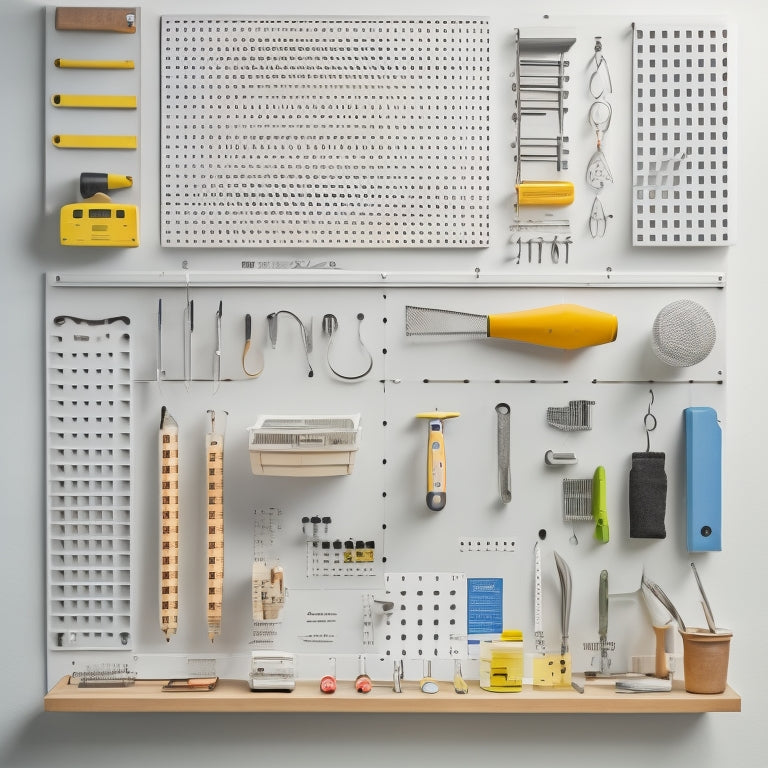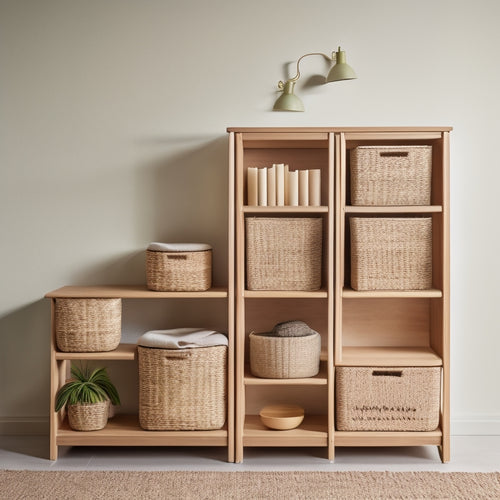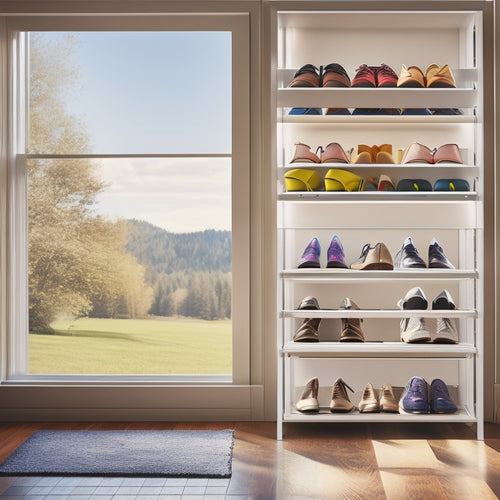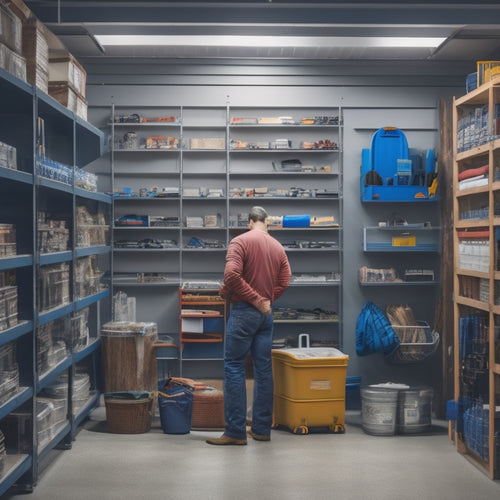
What Makes a Perfect Tool Pegboard for You?
Share
You need a pegboard that adapts to your unique tool collection, workflow, and workspace, providing a seamlessly organized and efficient storage system that enhances your productivity. To find it, assess your tool storage needs, considering types, quantities, and frequency of use. Then, customize your pegboard with adjustable hooks, bins, and magnetic strips to accommodate tools of varying sizes and shapes. Choose durable, moisture-resistant materials and a size that optimizes storage without overcrowding. Consider hook and accessory options, labeling, and security features to protect your tools. As you weigh your options, focus on creating a space that boosts your efficiency and sets you up for success.
Key Takeaways
• A perfect tool pegboard considers tool storage needs, frequency of use, and available space to optimize organization and efficiency.
• Customizable storage solutions, such as adjustable hooks and bins, accommodate tools of varying sizes and shapes.
• Durable and moisture-resistant materials, like high-quality pegboard materials, ensure a long-lasting and reliable storage system.
• A well-designed pegboard prioritizes tool security and protection with features like built-in locks, enclosed storage, and anchor points.
• Aesthetically pleasing designs that complement the workspace style, along with a cost-effective budget, complete the perfect tool pegboard.
Tool Storage Needs Assessment
Before designing a perfect tool pegboard, you need to evaluate your tool storage needs by considering the types and quantities of tools you have, how often you use them, and the available space you have for storage. This assessment will help you determine the most efficient space utilization and tool organization for your pegboard.
Take stock of your tools, categorizing them by frequency of use and grouping similar tools together. Identify the tools you use daily, weekly, and occasionally, and allocate space accordingly. Consider your personal preferences, such as having frequently used tools at eye level and less frequently used tools towards the top or bottom.
Think about the storage solutions you need, like bins, hooks, or trays, to keep small items organized and within reach. By understanding your tool storage needs, you'll be able to design a pegboard that maximizes your available space, streamlines your workflow, and reflects your unique needs and preferences.
Customization for Unique Tools
As you tailor your pegboard to your specific tool storage needs, you'll need to accommodate unique tools that don't fit standard storage solutions. This is where customization comes in – creating personalized solutions to make sure your tool organization is efficient and effective.
You may have tools with unusual shapes, sizes, or handles that require special consideration. To cater to these unique tools, consider the following:
-
Adjustable hooks: Allow you to customize the hook's width and depth to fit tools of varying sizes.
-
Customizable bins: Provide additional storage for small parts, screws, or other accessories that don't fit on standard pegs.
-
Magnetic strips: Perfect for storing small metal tools, such as wrenches, pliers, or screwdrivers.
- 3D-printed custom holders: Can be designed to fit specific tools, ensuring they're securely stored and easily accessible.
Pegboard Material and Durability
When choosing a pegboard, you're probably taking into account factors beyond just aesthetics. You're likely wondering what materials will withstand heavy tool use and endure the wear and tear of your workshop.
Now, let's explore the significance of board thickness and material strength to guarantee your pegboard stays durable and functional over time.
Board Thickness Matters
You're likely to find that pegboard thickness plays a critical role in determining the overall durability and performance of your tool organization system. A thicker board provides a more stable and secure surface for your tools, reducing the risk of warping or bending under weight. This is especially important if you plan to hang heavy tools or accessories.
When evaluating pegboard thickness, consider the following factors:
-
Material quality: A high-quality material can withstand heavy loads and resist wear and tear.
-
Weight capacity: Guarantee the board can handle the combined weight of your tools and accessories.
-
Moisture resistance: A thicker board can better resist moisture and humidity, reducing the risk of damage or warping.
- Ease of installation: A thicker board may be easier to install, as it provides a more stable surface for screws or other fasteners.
Material Strength Compared
Compare the strength and durability of different pegboard materials to make sure you choose the right one for your tool organization system, as the material's performance directly impacts its ability to hold your tools securely. You'll want to assess the material durability and weight capacity to guarantee your pegboard can handle the weight of your tools.
For instance, a pegboard made of high-density fiberboard (HDF) can support more weight than one made of medium-density fiberboard (MDF).
When evaluating material strength, take into account the longevity of the pegboard as well. A durable material will last longer, reducing the need for frequent replacements and minimizing its environmental impact. Look for materials with a high weight capacity and resistance to wear and tear.
Additionally, check the material's moisture resistance to make sure it can withstand humid environments. By choosing a pegboard made from a strong and durable material, you'll enjoy a reliable and long-lasting tool organization system that keeps your tools within easy reach.
Size and Space Considerations
Determine the dimensions of your pegboard by assessing the available space on your workshop wall or bench, as well as the number and size of tools you plan to hang. This will help you optimize your space and make sure that your pegboard fits comfortably in the designated area.
When considering the dimensions of your pegboard, remember that it's not just about the physical measurements. You should also think about:
-
Space optimization: how you can maximize your storage capacity without overcrowding the pegboard
-
Layout flexibility: how you can arrange your tools in a way that makes sense for your workflow
-
Size considerations: how the dimensions of your pegboard will impact the size and type of tools you can hang
- Storage efficiency: how you can use the pegboard to keep your tools organized and within reach
Hook and Accessory Options
When selecting the perfect tool pegboard, you'll need to contemplate the type of hooks that will best hold your tools.
You'll also want to think about the accessories you need, such as bins, baskets, or trays, and make sure they're compatible with your pegboard.
Pegboard Hook Style
You'll find that pegboard hook styles vary greatly, offering a range of hook and accessory options to tailor your tool organization system to your specific needs. This diversity allows you to choose the perfect hook style that complements your workspace and tool collection.
When selecting pegboard hooks, consider the following key factors:
-
Hook color choices: Choose from a variety of colors to match your tool aesthetic or create a visually appealing contrast. This can help you quickly identify specific tools or create a cohesive look in your workshop.
-
Attachment versatility: Look for hooks with multiple attachment points, such as clips, screws, or adhesive, to secure and provide flexible installation.
-
Hook material and durability: Opt for hooks made from high-quality materials like steel or aluminum to withstand heavy tool weights and frequent use.
- Specialized hook designs: Explore specialized hooks for specific tool types, like cordless drill holders or socket organizers, to maximize storage efficiency and reduce clutter.
Accessory Compatibility Matters
Frequently, the most efficient pegboard systems rely on a combination of hooks and accessories that work seamlessly together, allowing you to personalize your tool organization and maximize storage capacity. When selecting a pegboard, you should consider the type of accessories it's compatible with, as this will impact your overall tool organization.
Look for a pegboard that offers a range of accessory options, such as bins, baskets, and trays, to store small items like nuts, bolts, and screws. This will enable you to create an organized and visually appealing accessory display.
Moreover, check if the pegboard is compatible with your existing tools and equipment. You want to make sure that the hooks and accessories are designed to hold the weight and size of your tools, ensuring tool compatibility. A well-planned accessory arrangement will help you quickly find the tools you need, saving you time and increasing productivity.
Customization Options Available
With an impressive array of hook and accessory options, you can tailor your pegboard to fit your unique tool collection and workflow requirements. This level of customization allows you to create a system that's truly yours, making it easier to stay organized and focused on the task at hand.
Some of the customization options you can explore include:
-
Personalized designs: Choose from alternative colors and designs to match your workshop's aesthetic or personal style.
-
Unique layouts: Create a custom layout that accommodates your specific tools and accessories, ensuring everything has its designated spot.
-
Creative displays: Use accessories like bins, baskets, or shelves to create a visually appealing display that showcases your tools and supplies.
- Specialized hooks: Select from a variety of hooks designed for specific tools, such as hammers, screwdrivers, or pliers, to keep them organized and within reach.
Mounting and Installation Methods
Mounting your pegboard requires careful planning and execution, as the method you choose will greatly impact the overall functionality and durability of your tool organization system. When it comes to installation, you'll want to think about the weight capacity of your pegboard and the type of tools you'll be hanging. Look for installation tips and mounting tricks online, such as using wall anchors or stud-mounted screws for added stability.
Hanging techniques can also make a big difference in the efficiency of your pegboard. Explore space-saving ideas like hanging your pegboard on a wall or the back of a door to maximize storage space. You can also utilize hooks and bins to store smaller items, keeping them organized and out of the way.
When deciding on a mounting method, consider the flow of your workspace and how you'll be using your tools. By choosing the right installation method, you can ensure a sturdy and functional pegboard that meets your needs.
With a little planning and creativity, you can create a pegboard that's both functional and visually appealing.
Key Organization and Labeling
When designing your perfect tool pegboard, you'll want to assign specific zones for each type of tool to maintain organization and maximize efficiency.
By doing so, you'll be able to quickly identify where each tool belongs, making it easier to find what you need when you need it.
Next, you'll need to label each zone and tool accordingly, ensuring that everything has a designated home and reducing clutter.
Pegboard Zone Assignment
You'll divide your pegboard into distinct zones, each dedicated to a specific category of tools or accessories, to maintain a logical and functional organization. This zone optimization allows for efficient tool arrangement, making it easier to find what you need when you need it.
By categorizing your tools and accessories into separate zones, you'll experience a significant boost in productivity.
Here are some zones to contemplate:
-
Hand tools: hammers, screwdrivers, pliers, and wrenches
-
Power tools: drills, saws, sanders, and routers
-
Fasteners: nails, screws, bolts, and nuts
- Measuring and testing tools: tape measures, levels, and multimeters
Labeling for Efficiency
Labeling each zone and tool location on your pegboard is essential for maximizing efficiency, as it enables you to quickly identify where a specific tool is stored. This organizational tip will save you time and frustration when searching for a tool.
You can use labels, stickers, or even a marker to write the name of each tool or zone on the pegboard. Be sure to label each zone clearly, such as 'Hand Tools' or 'Power Tools,' and then label each individual tool hook or bin. This will help you to quickly locate the tool you need and prevent you from wasting time searching for it.
When labeling your pegboard, consider using a consistent font and color scheme to make it easy to read and understand. You can also use pictures or icons to help you quickly identify the tool or zone. For example, you could use a picture of a hammer next to the label 'Hammers' to make it easy to identify.
Tool Security and Protection
Protect your tools from theft, damage, and misplacement by investing in a pegboard with built-in locks or investing in separate locking systems specifically designed for tool storage. This is an essential aspect of tool organization, as it guarantees that your valuable tools are safeguarded and easily accessible when you need them.
A pegboard with a locking system allows you to organize your tools in a space-efficient manner while keeping them safe from unauthorized access.
When it comes to tool security and protection, consider the following key features:
-
Locking hooks: Look for pegboards with locking hooks that can be secured with a key or combination lock to prevent tools from being removed without authorization.
-
Enclosed storage: Consider a pegboard with enclosed storage compartments to keep tools out of sight and protected from dust and debris.
-
Anchor points: Guarantee your pegboard has anchor points to secure it to the wall or floor, preventing it from being moved or stolen.
- Weather-resistant materials: Opt for a pegboard made from weather-resistant materials to shield your tools from environmental factors like moisture and extreme temperatures.
Aesthetics and Workspace Style
With a pegboard that complements your workspace style, you can create a visually appealing and functional area that boosts your productivity and morale. A well-designed pegboard can elevate your workspace design, making it more organized and efficient.
When choosing a pegboard, consider the color coordination of your workspace. If you have a lot of bright colors, a pegboard with a similar tone can create a cohesive look. On the other hand, if your workspace is more neutral, a pegboard with a pop of color can add visual interest.
You can also consider the material and finish of your pegboard to make sure it blends seamlessly with your workspace aesthetic. For example, a wooden pegboard can add a warm, rustic touch, while a metal pegboard can provide a sleek, modern look.
Budget and Cost Effectiveness
You'll also want to take into account the financial implications of your pegboard choice, as the cost can vary greatly depending on the size, material, and features you need. While it's tempting to go for the cheapest option, consider the long-term benefits of investing in a high-quality pegboard.
A durable and well-designed pegboard can provide long-term savings by reducing the need for frequent replacements and minimizing tool damage.
Here are some key considerations to keep in mind:
Quality investment: A premium pegboard may cost more upfront, but it can withstand heavy use and last for years to come.
Cost effective solutions: Look for pegboards with adjustable hooks and customizable layouts to maximize storage capacity and reduce waste.
DIY options: If you're on a tight budget, consider DIY pegboard kits or repurposing an old pegboard to save money.
Hidden costs: Factor in the cost of accessories, such as bins and baskets, and any additional features you need, like a pegboard with a built-in work light.
Frequently Asked Questions
Can I Use a Pegboard for Non-Tool Items Like Bags or Accessories?
Just like a Swiss Army knife, you're thinking outside the box, wondering if pegboards can hold more than just tools. And the answer is yes! You can repurpose pegboards for home organization and decor, or even as a retail display and storage solution for bags and accessories.
How Often Should I Clean and Maintain My Pegboard?
You should clean your pegboard every 1-2 weeks, dusting hooks and wiping down the board. Regularly inspect for damage and reorganize items to maintain best use; consider categorizing tools and using dividers for a visually appealing display.
Are Pegboards Suitable for Outdoor or Garage Use?
Imagine your pegboard withstanding harsh outdoor conditions like a ski resort's maintenance shed. For outdoor or garage use, look for weather-resistant materials and durable construction; then, customize with versatile hooks and bins to organize your gear efficiently.
Can I Integrate a Pegboard With My Existing Workshop Layout?
You can seamlessly integrate a pegboard into your existing workshop layout by designing a custom layout that maximizes organization, enhancing workshop efficiency, and streamlining your workflow with a well-planned integration strategy.
Are There Pegboards Specifically Designed for Left-Handed Users?
You're looking for pegboards designed with left-handed ergonomics in mind, and yes, some manufacturers offer customized solutions catering to your needs, ensuring comfortable and efficient tool access, tailored to your unique preferences.
Related Posts
-

Open Storage Bins for Shelving Units
You need open storage bins that integrate seamlessly with your shelving units to boost your organization, productivit...
-

Adjustable Modular Shoe Racks for Versatility
Adjustable modular shoe racks are your go-to solution for versatile and organized footwear storage. These racks maxim...
-

Building Garage Shelves in 7 Easy Steps
You're about to convert your garage into a highly functional storage space by building custom shelves in just 7 easy ...


